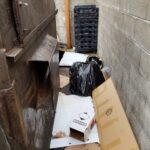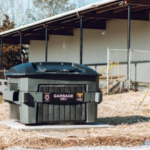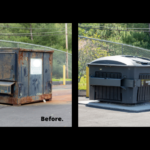What is the best way to handle solid waste (trash) for restaurants?
There are a lot of factors involved when handling solid waste and taking out the trash for restaurants, eateries, deli’s, etc. It sounds simple. Take it to the dumpster and get rid of it.
Right, but here are some of the challenges we face: Nothing kills the appetite quicker than seeing a rat run into a trash corral, but a close second is bad odor wafting from the trash area to an outdoor eating area either. Illegal dumping of trash into your container, like mattresses, tires, old furniture, etc., that not only fills up your bin but you pay to get rid of it.
Below is an in-depth overview of dumpster challenges in the order of annoyance and frustration:
Customer Facing Issues:
Odor/Smell
- If a container is exposed to the elements (heat in summer in particular) and if it is not sealed properly, odor is a common by product of storing trash. This might be emanating from the container itself or it could be from the runoff of “dumpster juice” running out of the container.
- Temperature is the greatest factor for odor due to the temperatures at which bacteria grows and multiplies. Bacteria grows best in temperature range of 80F to 105F which is where most dumpster temperatures will be in the late spring through early fall seasons in North America.
Rodents/Vermin
- No quicker way to kill the appetite than to see rats run in/out of a trash area while sitting in a drive through or at an outdoor eating area. Customers will literally stand up and leave or drive off and you may never know why.
Unsightly Trash Containment Area
- While most restaurants have an enclosure with gates, it is rare that customers don’t see into these areas on a regular basis when the gates are inevitably left open. Few managers are able to keep the area clean inside the walls. Trash on the ground and junk being stored inside the trash enclosure is at the least tarnishes your Brand.
Management/Property Owner Issues:
Safety Concerns:
- Many restaurants prohibit workers from taking the trash out after dark.
When people use the trash enclosure for purposes other than just storing trash it can become a haven for criminal activity. Persons taking out the trash may find themselves in a compromising situation by unintentionally surprising someone that may be using the enclosure to (a) hide from authorities (b) live in or (c) do illicit activity. Someone may be in the enclosure for the express purpose of waiting for someone to come there alone and unsuspecting.
- Occupational hazards, of which heavy lifting (back injury) and slipping/falls are the leading causes. Dumpsters, by definition, are designed with the hauling and service in mind rather than the user who is taking the trash out. To fill them up to the top, you need a step ladder or if you rather climb up the side that is up to you. They are not exactly user-friendly and the person putting the trash in is often exposed to an unsafe working environment.
Health Concerns:
- Many municipalities require a sign off from the local health department for enclosure design in order to minimize the spread of disease and infection from small rodents, birds and other varmints that frequent trash enclosure areas. Some of these departments have ordinances that require hose bibs to wash down the enclosures, some even requiring hot water, some require and sanitary drain including in some cases, grease traps, etc.
- Extra requirements not only involve more investment on the part of the owner, it also adds to the expense to treat the water at the wastewater facility adding more load to the system and more burden to the municipality itself.
- Transient persons, homeless people and even criminals often use trash enclosures for nefarious purposes. The potential for the spread of disease is increased.
- Persons taking the trash out often come in contact with trash, garbage, and rotten food on the ground in the confines of the enclosure. At times, they are repulsed by the task and just leave the trash inside the enclosure but not in the garbage container. Out of sight, out of mind. This leaves the trash very accessible to other persons or animals to exploit it and spread it around.
Environmental Issues:
- Dumpsters are typically not sealed. The lids usually have large gaps, often are in disrepair, are missing, or are just simply left open. This allows two things: A) rainwater into the container and B) smells/odor to escape the container.
- Most dumpsters have a drain hole at the bottom that allows the water (that shouldn’t be in there to begin with) to exit the container and potentially contaminate nearby stormwater systems.
- Rusting containers. While the rust and disintegration of the container itself are not good for the environment, the real problem is the holes where the container has rusted through in which garbage, trash and potentially harmful substances are leaked into the surrounding waste ways.
Sustainability Concerns:
- If a garbage truck driver is required to park, get out of the truck, unlock/open gates and then repeat the same process in reverse after emptying the dumpsters, they have added at least 3 minutes to that particular stop. A front-load dumpster truck does an average of 100 stops per day. If 50% of those stops have gates that are open/closed by the driver, that equates to an additional time of 2.5 hours. That is 2.5 hours of man hours plus 2.5 hours of fuel burn for one truck on one route. One of the four major haulers in American has over 10,000 trucks in route on any given day. Do the math.
Land Use:
- Trash enclosures are generally much larger than the dumpster that is housed inside.
- A typical trash enclosure has a 14×14 footprint (192 sq.ft) The dumpster that is inside has a footprint of 6.5 x 7 (46 sq.ft) that is 4X the space simply to hide the dumpster.
- A 8” thick concrete pad is always needed in an enclosure and is part of the impervious surface area considered on a site plan.
- Gate-swing area also has to be considered in the site plan for access to the dumpsters and often adds the required footprint for solid waste storage area.
What are the solutions to these issues?
In-ground waste containers answer all the above challenges. You can explore different manufactures products on their websites below.
You will need to find which one best fits your needs. Some of these systems, such as Sutera and Molok require special trucks to empty them while others like Binova’s EnviroBIN offer containers that can be handled by any company that offers “front load” or “dumpster truck” services making them usable in virtually any town.
www.ingroundwastecontainer.com
In a nutshell, in-ground containers offer the following:
- More attractive design, generally screening requirements are reduced/waived. No gates to maintain.
- Gravity locked lid, no dumpster diving, no bulky items in container (mattresses, tires, etc)
- In-ground waste stays cooler therefore the odor is reduced
- Rotomolded PE container, will not rust.
- No access for pests/ rodents / vermin
- Helps meets Sustainability goals
- No run-off of “dumpster juice” improving environmental conditions
Easier to load, minimizing worker comp claims








